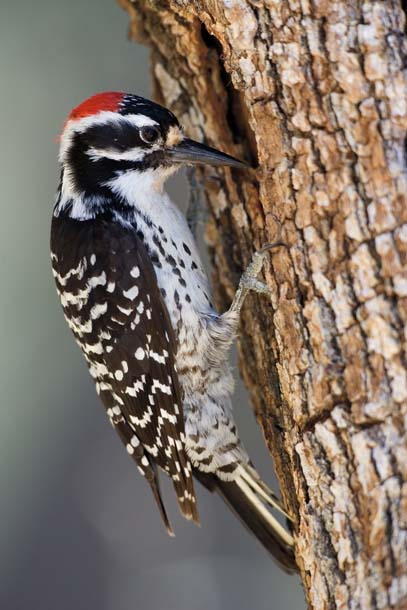Raising young is perhaps the most important act any species performs, and among the most challenging. If you think we humans have a tough time, consider the process for many birds. During a typical nesting season–especially for birds that nest in trees, in shrubs, or on the ground–parents, eggs, and young are extremely vulnerable to predators and bad weather. Wouldn’t those birds love to have a roof over their heads? Well, some do. Birds called cavity nesters minimize those challenges by essentially nesting indoors, in holes in trees or other sheltered places.
Woodpeckers play an extremely important role in the cavity nesting community, excavating homes for themselves that may also be used by many other birds. Woodpeckers typically create cavities in the trunks or branches of trees. Most species make a neat, round hole that leads to a sunken chamber hollowed out in the heartwood, usually in an area softened by decay or disease. They tap at trunks and branches to search for a section of the tree that sounds like it has a soft (or even hollow) core. Woodpeckers can be quite picky about the location of the entry hole, often situating it just below a branch to shield it. Some species will make the opening on the undersides of branches or trunks that rise at an angle to keep rain from flowing in.
- A Nuttall’s woodpecker at its nest hole. Woodpeckers excavate cavities later used by other species of birds. Photo by Bruce Finocchio, dreamcatcherimages.net.
Most woodpeckers make a new nest every year; some create second cavities for the non-incubating parent. Once the woodpeckers are done with these cavities, other species move in. In fact, most cavity nesters prefer holes created by woodpeckers. Mature trees can also provide natural cavities: Scars where branches have rotted off can expose decayed wood. Titmice, chickadees, and nuthatches can peck and scratch their way into these scars to hollow out a nest, but they’ll also use abandoned woodpecker nests or other existing cavities.
Virtually all of our cavity nesters breed at the same time of year (generally March through May), so there’s considerable competition for nest sites. And then it’s a race against time to pack in the one to two weeks for nest construction, two to three weeks of incubation, and two to four weeks of tending the young before fledging. During nest construction, one bird may remain inside the cavity to defend it while the mate gathers nesting material. Cavities may also be used more than once during a single season; late-arriving migratory species (such as ash-throated flycatchers) or birds pushed out of another site might have to wait until another family is finished with a particular cavity.
Not all cavities are in trees: Burrowing owls typically breed in burrows dug by ground squirrels. Belted kingfishers and bank swallows dig horizontal shafts into vertical banks. Northern rough-winged swallows use abandoned bank swallow nests or rodent burrows, or they enlarge nooks in vertical banks. They also use holes in retaining walls and ventilation or drainage shafts in concrete structures. White-throated swifts usually nest in crevices in cliff faces, but they too will nest in the expansion joints and vents of buildings and other structures. House and Bewick’s wrens show an amazing plasticity in their choice of nest sites: they’ll use woodpecker holes or natural cavities, but they’ll also nest in upturned flowerpots, boots, barbecues, and even hidden recesses in old tractors, cars, or other abandoned vehicles.
Of course, another man-made structure used by cavity nesters is the birdhouse. Western bluebirds, tree swallows, and many other species will readily accept birdhouses, which is a good thing, since there’s an ever shorter supply of the mature or dying trees these birds naturally seek out. To learn where to put birdhouses, how to maintain them, and how to take part in related citizen science research, check out the Cavity Nesters Recovery Program sponsored by the Santa Clara Valley Audubon Society.
Although many birds will nest in structures we build, we’re also responsible for negative impacts. The introduced European starling aggressively excludes many native species from nests, and removal of dead limbs and harvesting of mature trees eliminates many nesting sites. So the next time you contemplate removing an old tree or cutting off a dead limb, consider the birds that might nest there, and the pleasure you’ll get from their company.

.jpg)




